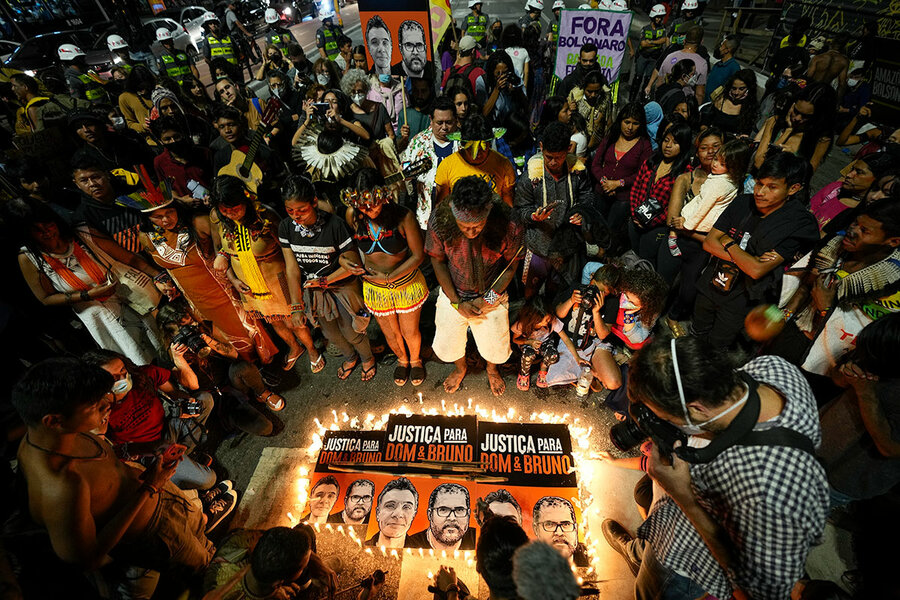‘Nowhere to hide’: After murders in Amazon, local journalists at risk
Loading...
| Cruzeiro do Sul, Brazil
The Amazon is touted as the “lungs of the planet” and is regularly mentioned in climate debates around the world. Yet for those living in and around the vast tropical forest, the international name recognition has masked a historic pattern of invisibility, where organized crime, land conflicts, and violence are left to flourish.
This contrast was brought to light one year ago today, when British journalist Dom Phillips and Indigenous expert Bruno Pereira went missing while traveling the Itaguaí River in the Brazilian Amazon. Mr. Phillips was researching a book that was to be titled “How To Save the Amazon.” Ten days later, they were found murdered.
The case shocked the world, raising the veil on the crises of organized crime and scarce law enforcement that dominate Amazonian border regions, especially where Brazil meets Colombia and Peru. And it ignited calls for stronger protections for anyone working to defend the Amazon.
Why We Wrote This
A story focused onThe Amazon name may be ubiquitous, but the tragic murder of a reporter and environmentalist there last year highlights the invisibility of so many of the forest’s risks and realities.
But perhaps nowhere have the ripples of this tragedy been more acutely felt than among local journalists, who every day weigh their own safety against their responsibility to inform the public.
“The murders are the tip of the iceberg,” says Daniel Giovanaz, a project coordinator at Reporters Without Borders, who began monitoring threats to journalists in nine states of the Brazilian Amazon a month after the men were killed. Their findings include cases of direct threats of violence or death, abusive judicial processes meant to incriminate reporters, and cyberattacks or hacking.
“You have an environment that is extremely hostile to plurality, to independence, to freedom of expression at large,” Mr. Giovanaz says. When a journalist is silenced, whether by direct threat or self-censorship, “that violates the right of all society to have access to reliable information of public interest.”
“We know what’s going on”
Reporting in the Amazon has never been for the faint of heart. There are the inherent dangers of the jungle, from limited to no access to cell or internet services, to natural predators like anacondas and venomous spiders. Communities are often isolated, requiring travel along lonely rivers. Long-simmering land conflicts between farmers, miners, rubber tappers, and environmental and Indigenous activists mean outsiders are often viewed with skepticism. The growing presence of drug trafficking organizations has raised the stakes.
In a small city on the other side of the Javari Valley from where Mr. Phillips and Mr. Pereira were shot by illegal fishers, reporter Glédisson Albano counts out on his fingers the number of times he’s been threatened for doing his job.
There was the time he sprinted away from a tractor barreling toward him while reporting on waste dumping in a protected area. Just the other day, he was told he better be careful what he publishes, or he’ll get what is coming to him, he says.
Organized crime networks began operating in Cruzeiro do Sul in 2017, a time when he says he was reporting three or four deaths a day.
“It’s a small town; there’s nowhere to hide,” he says, looking out from his favorite hillside vista before beginning his workday. “If they want to threaten you, they do. They know where your house is, who your family is.”
When Mr. Albano heard the news about Mr. Phillips and Mr. Pereira last year, his heart sank. The two had been meeting with riverine and Indigenous communities to learn about their efforts to surveil the Javari Valley, Brazil’s second-largest Indigenous territory. Mr. Pereira was well known in the area for his efforts to stop illegal fishing and hunting. The men received death threats from illegal loggers, miners, and drug traffickers before they disappeared.
The Indigenous Missionary Council reported over 300 cases of land invasions, illegal exploitation of natural resources, and damage to property across 226 Indigenous territories in 2021. That’s nearly three times as many cases reported in 2018. Anyone perceived to pose a threat to those activities is at risk.
“We know what’s going on, but we can’t speak about it as we want to,” says Mr. Albano. He has watched colleagues leave journalism because of the danger.
“I feel obligated to cover, to publicize, to show what’s happening. That force takes us out of the house and makes us fight our fears,” he says.
Always an “eye on you”
Protections for journalists and environmental defenders already exist in Brazil, but human rights organizations and others are calling for them to be strengthened – and better enforced.
The two fishers who confessed to the crime are being held in prison awaiting trial, along with a third man who denies involvement. Two more men – suspected of involvement in the kind of illegal fishing Mr. Pereira was trying to halt – were also charged last week.
But locals say there needs to be an end to impunity in cases that don’t attract international attention, too. There were 44 journalists killed for their work in Brazil over the past three decades, and 62 more in neighboring Colombia and Peru, according to The Committee to Protect Journalists.
“If they do this with a reporter like Dom Phillips, an international reporter, without even thinking about it, imagine us who are from the region,” says Fabio Pontes, a freelance journalist from Acre’s capital city of Rio Branco. “We are much more exposed.”
Moving around in remote areas of the Amazon, whether by plane or riverboat, can be prohibitively expensive for freelance reporters. When he does travel, Mr. Pontes always goes accompanied by locals who know the areas. He no longer broaches questions of drug trafficking or organized crime.
“There is always someone who has their eye on you,” he says.
One outlet he works with is Amazônia Real, created in 2013 to re-imagine the role of reporting in the Amazon. Local and Indigenous people are central to their coverage, and the organization was one of the first independent outlets to report on the disappearance of Mr. Phillips and Mr. Pereira. They were tipped off by an Indigenous contact in the area.
“One of the big mistakes of journalism is to homogenize the Amazon region, as if it was one thing,” says Elaíze Farias, co-founder of Amazônia Real. “You have to pay extra close attention to the advice of locals.”
An even greater challenge for journalists who remain in the field, adds Mr. Pontes, is to “do journalism from the Amazon for those who are in the Amazon,” instead of audiences in São Paulo or New York. He says journalism will only thrive once populations here begin to value the forest and the local voices within it.
The Bruno and Dom Project
A few weeks before his death, Mr. Phillips stopped at an Ashaninka Indigenous village along the Amônia River. Dora Piyãko, a leader there, agreed to speak. She saw his reporting as important for her community’s struggle to protect their territory and culture.
The subsequent news of his and Mr. Pereira’s death was a shock. Local leaders came up with new safety protocols: Walkie-talkies became essential, community members now check in with those in the village frequently when monitoring the territory or traveling beyond its borders, and they try not to move around alone.
“We must be more careful now with whom we decide to speak, where we go,” says Ms. Piyãko. “We can’t always talk with the media because it could be risky.”
In a sign of solidarity – and hope – the work that Mr. Phillips and Mr. Pereira dedicated themselves to in the final years of their lives persists. More than 50 Brazilian and international journalists are continuing to investigate the destructive activities taking place in the Amazon as part of The Bruno and Dom Project. And a group of colleagues and friends of Mr. Phillips are raising funds to complete his reporting and publish his book. The work of Amazon defenders, and those willing to take the risk to report on it, lives on.









